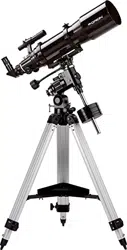Loading ...
Loading ...
Loading ...

Observers in the Southern Hemisphere aren’t so fortunate to
have a bright star so near the south celestial pole (SCP).The
star Sigma Octantis lies about 1° from the SCP, but it is bare-
ly visible with the naked eye (magnitude 5.5).
For general visual observation, an approximate polar align-
ment is sufficient:
1. Level the equatorial mount by adjusting the length of the
three tripod legs.
2. Loosen one of the latitude adjusting T-bolts and tighten the
other to tilt the mount until the pointer on the latitude scale
is set at the latitude of your observing site. If you don’t
know your latitude, consult a geographical atlas to find it.
For example, if your latitude is 35° North, set the pointer
to +35.The latitude setting should not have to be adjusted
again unless you move to a different viewing location
some distance away.
3. Loosen the Dec. lock lever and rotate the telescope opti-
cal tube until it is parallel with the R.A. axis. The pointer
on the Dec. setting circle should read 90°. Retighten the
Dec. lock lever.
4. Move the tripod so the telescope tube (and R.A. axis)
points roughly at Polaris. If you cannot see Polaris direct-
ly from your observing site, consult a compass and rotate
the tripod so the telescope points north. There is a label
bearing a large “N” at the base of the equatorial mount
(Figure 8). It should be facing north.
The equatorial mount is now approximately polar-aligned for
casual observing.More precise polar alignment is required for
astrophotography and for use of the manual setting circles.
Note: From this point on in your observing session, you
should not make any further adjustments to the latitude of
the mount, nor should you move the tripod. Doing so will
undo the polar alignment.The telescope should be moved
only about its R.A. and Dec. axes.
The Polar Axis Finder Scope
A nice feature of the AstroView 120ST is the polar axis finder scope
housed inside the R.A.axis of the equatorial mount (see Figure 4).
When properly aligned and used, it makes accurate polar align-
ment quick and easy to do.Alignment of the polar finder need only
be done once, unless it gets bumped or otherwise shifts its position.
Remove the round cover cap from the front opening in the R.A.
axis of the mount (see Figure 6). Look through the polar finder
at a distant object during the day.Focus the polar finder so that
the images and reticle are sharp by rotating the eyepiece end
of the finder. Notice that the reticle pattern consists of a
crosshair with a circle around the middle.On the circumference
of this circle is a tiny circle; this is where Polaris will be placed
for accurate polar alignment once the finder is properly aligned.
Alignment of the polar finder is best done during the day, before
going out into the field at night.
Aligning the Polar Axis Finder Scope
Aligning the polar axis finder scope so that it will accurately
point at the true north pole is a two-step procedure. First, the
polar finder must be rotated in its housing so that the small
circle in which Polaris will be placed in is in the proper initial
position. Next, the polar axis finder must be adjusted so that
it points directly along the mount’s R.A. axis.
We will start by aligning the polar finder rotationally. Refer to
Figure 4.
1. Loosen the large thumbscrew just above the R.A. setting
circle. Rotate the R.A. setting circle until the line above the
“0” on the setting circle lines up with the pointed indicator
that is cast into the mount (located directly below the large
8
Figure 7.
To find Polaris in the night sky, look north and find the Big
Dipper. Extend an imaginary line from the two "Pointer Stars" in the
bowl of the Big Dipper. Go about five times the distance between
those stars and you'll reach Polaris, which lies within 1∞ of the north
celestial pole (NCP).
Big Dipper
(in Ursa Major)
Little Dipper
(in Ursa Minor)
Cassiopeia
N.C.P.
P
o
i
n
t
e
r
S
t
a
r
s
Polaris
Figure 8. For polar alignment, position the tripod so that the "N"
label at the base of the mount faces north.The two azimuth fine
adjustment knobs above it are used to make small adjustments to
the mount's azimuth position.
Azimuth fine
adjustment knobs
Tripod attachment
knob
Loading ...
Loading ...
Loading ...
